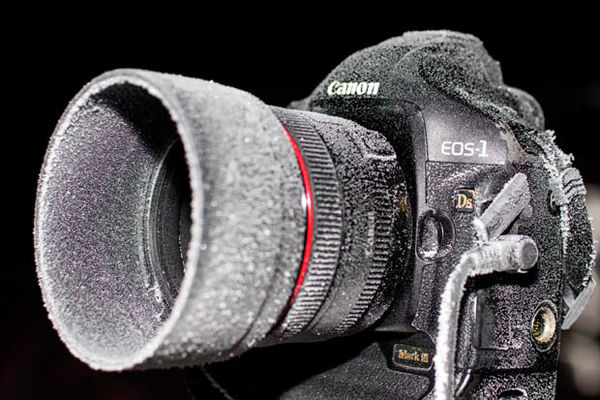PHOTOGRAPHING IN THE COLD below freezing
Feb 17, 2019 12:58:38 #
wdross
Loc: Castle Rock, Colorado
Gene51 wrote:
I've used my Sony, Fuji and Nikon digital gear for years in sub-zero conditions without mishap. You should exercise caution when bringing a camera into a warm humid house, however. I usually leave the camera in the garage for an hour or two, which is never colder than 36° and often in the mid-40s, where it acclimates to the warmer temp. Then I leave it in the mudroom for a bit, and ultimately bring it inside.
Best advice for transition. Unless you have a weatherproof camera like the E-M1mrII, if it is brought in from the cold, and develops moisture on the outer surface, do not operate the camera until it is warm and dry.
Feb 17, 2019 13:00:41 #
rodder wrote:
what protection do I need to give the camera during shooting and after back in the warm?
This is an interesting article:
https://petapixel.com/2012/12/20/frozen-camera-what-a-dslr-looks-like-when-shooting-in-a-25c-environment/
Feb 17, 2019 13:41:14 #
tiphareth51 wrote:
Fairbanks, Alaska...home of below zero temps chimi... (show quote)
I do the same but I also put a small dessicant pack in the bag with the camera
Feb 17, 2019 14:00:19 #
Would the use of a desiccant assist in the prevention of moisture damage when sealed in the ziplock?
Feb 17, 2019 14:30:47 #
appealnow
Loc: Dallas, Texas
Do y'all have any advice for taking camera from air-conditioned to warm, moist. Traveling in Viet Nam I had problems leaving the boat on the river (AC) for an excursion. Would take up to 30 minutes for the condensation to go away. I had problems the night of the lunar eclipse because of the cold. Every time I left my house, the condensation never seemed to go away before I gave up.
Feb 17, 2019 16:31:37 #
wdross
Loc: Castle Rock, Colorado
lbrande wrote:
Would the use of a desiccant assist in the prevention of moisture damage when sealed in the ziplock?
Absolutely. Just make such the desiccant packaging is in good shape. I'm not sure how good desiccant is "poured" all over a camera.
Feb 17, 2019 18:48:24 #
idrockman
Loc: Boise, Idaho
tiphareth51 wrote:
Fairbanks, Alaska...home of below zero temps chimi... (show quote)
I agree 100%, was up north of Fairbanks photographing the Aurora at -32 below zero F, and the only thing that stopped me from going longer than 1 hour was only 3 spare batteries. I have a Canon EOS T6 and it held up great at this email cold temps. But yes, cover your lens prior to warming it up.
Feb 17, 2019 18:51:01 #
wdross wrote:
Absolutely. Just make such the desiccant packaging is in good shape. I'm not sure how good desiccant is "poured" all over a camera.
I have desiccant in good solid packaging.
Feb 17, 2019 20:18:19 #
When it's -20F batteries drain pretty fast but I've never had a camera freeze up on me, I kind of question the conclusions of that article. I mean- cell phones work fine at those temps and so do most point and shoots, I would be mighty annoyed if a pro level camera or lens gave up the ghost. It does look like his problem was hoarfrost and if he'd covered his camera with a tarp or tent it would have prevented a lot of that.
My method is to wear touch sensitive thin gloves, possibly the kind with a mitt cover if needed. I work quickly and once I'm done I stick my hands back into some Hestra Primaloft Extreme Liner Mitts that I keep leashed to my sleeves. Those things are WARM and you can add hand warmers for extra oomph. Also I don't carry my tripod in my hand ever- even with foam the metal sucks the warmth right out of your fingers.
My method is to wear touch sensitive thin gloves, possibly the kind with a mitt cover if needed. I work quickly and once I'm done I stick my hands back into some Hestra Primaloft Extreme Liner Mitts that I keep leashed to my sleeves. Those things are WARM and you can add hand warmers for extra oomph. Also I don't carry my tripod in my hand ever- even with foam the metal sucks the warmth right out of your fingers.
Feb 17, 2019 21:41:41 #
wdross wrote:
Absolutely. Just make such the desiccant packaging is in good shape. I'm not sure how good desiccant is "poured" all over a camera.
Dessicant only works in sealed bags, and once it has adsorbed (not a typo) what moisture it can, it must be recharged by drying it out. Many who advocate don't understand the difference between adsorption and absorption, and the fact that before a dessicant can be reused it must be dried.
Feb 17, 2019 22:36:58 #
wdross
Loc: Castle Rock, Colorado
Gene51 wrote:
Dessicant only works in sealed bags, and once it has adsorbed (not a typo) what moisture it can, it must be recharged by drying it out. Many who advocate don't understand the difference between adsorption and absorption, and the fact that before a dessicant can be reused it must be dried.
Hopefully the OP, having some, knew about that before. If not, you have just informed all possible users to dry the desiccant out before use. A lot of times they put the instructions on the desiccant container.
Feb 17, 2019 22:59:22 #
Gene51 wrote:
Dessicant only works in sealed bags, and once it has adsorbed (not a typo) what moisture it can, it must be recharged by drying it out. Many who advocate don't understand the difference between adsorption and absorption, and the fact that before a dessicant can be reused it must be dried.
Thanks for the clarification on the reuse of desiccant.
Feb 18, 2019 06:48:38 #
I was out last night in Oswego, temp +2 with 20 mph wind with my Nikon D7100 (magnesium body) and the batteries froze in camera. So I placed an extra battery in each shirt pocket and went about my business. When one battery froze, just switched with a warm one... bothersome, but no big deal.
Feb 18, 2019 11:37:33 #
In general, always keep camera batteries warm and charged. Since it's warm/humid when one comes inside condensation forms quickly. We use a highly absorbent microfiber cloth to wipe/wick most of the initial surface moisture off and make use of a 'warming' room near the entrance, with a table to set the gear and small fan nearby to provide indirect air-flow which quickly dissipates moisture. Also leave the battery card and connector doors/flaps open. Was out with both tripods, and 150-600mm lens during the last round of moon photography, and we were so numb, it was all I could to to pull the battery and card; left the rest sitting on the tripod next to the door, with a light absorbent anti-static cover over camera/lens. Checked it about 30 minutes later and all was wall. Have always uses 'thinsulate' style gloves, but the older one gets, the less we like playing in the blowing snow:)
Feb 18, 2019 13:17:04 #
We had a local presentation by a couple who went on a Photo trip to Antarctica and they used something like those ziplog bags or dry bags that paddlerdon mentioned above. They said that they obtained them a sporting goods store that catered to Hunters and Fisherman. The two bags that they showed us were able to fit a fairly large amount of cameras and lenses. They used them on boat trips to view glaciers and other parts of their trip and could also be used when ever your equipment can be protected from rain or water.. This was much better then my backpack and the rain cover that it comes with.
If you want to reply, then register here. Registration is free and your account is created instantly, so you can post right away.



